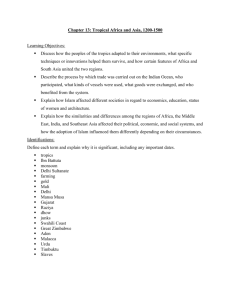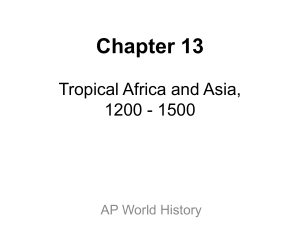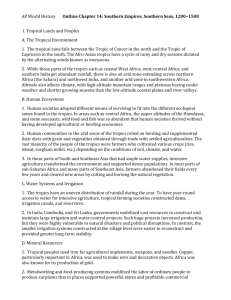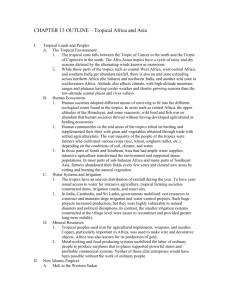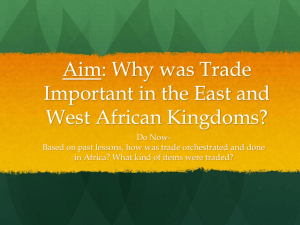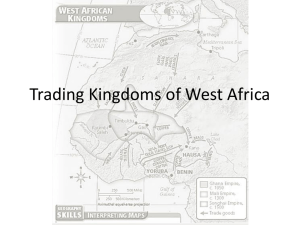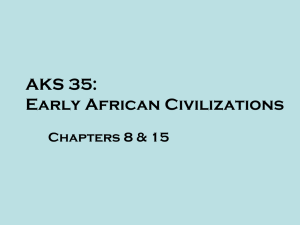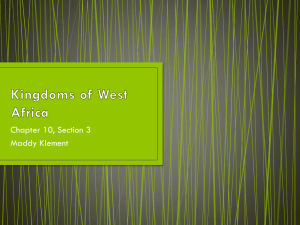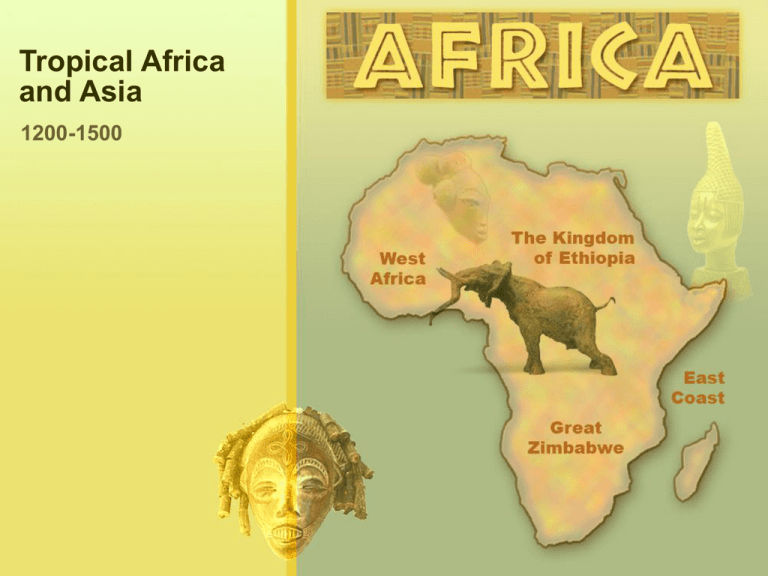
Tropical Africa
and Asia
1200-1500
The Tropical Environment
The Tropical Environment continued
•In South and Southeast Asia, ample water
supplies, intensive agriculture, supported
dense populations
•SE Asia and SSA, slash and burn agriculture
•Uneven distribution of rainfall
•So, constructed dams, irrigation canals and
reservoirs.
•In India, Cambodia, Sri Lanka, govt’s mobilized
vast resources to construct and maintain large
irrigation and water-control projects.
•These projects were highly vulnerable
Africa and the Indian Ocean
Basin: Physical Characteristics
Mineral Resources
•Iron—used for farm tools, weapons and needles
•Copper—used for wire and decorative objects
•GOLD
Ordinary people were used for labor in
metalworking and food-producing to create
surpluses to support powerful states and profitable
commercial systems
New Islamic Empires
Mali in the Western Sudan
Delhi Sultanate in India
The Kingdom of Mali
Mali Empire
Islam spread to sub-Saharan Africa by a gradual
process of peaceful conversion. Conversion was
facilitated by commercial contacts.
In 1240, Muslim leader established the kingdom
of Mali.
Mali’s economy: agriculture
Supplemented trans-Saharan trading and control of the
gold mines of the Niger headwaters
Trade essential to empire; education
encouraged; women not veiled
The kingdom of Mali collapse: rebellion within
and attacks from without
Cresques map, Africa,
of Mansa Musa
A caption identifies the black ruler as
Mansa Musa, "the richest and noblest
king in all the land."
Mansu Masu
The Mali ruler Mansa Kankan Musa (r.
1312–1337) demonstrated his fabulous
wealth during a pilgrimage to Mecca
Mansa Musa established new mosques and
Quranic schools upon return
Mansu represented opulent wealth while
his subjects remained largely the opposite
India and the Delhi Sultanate, ca.
1300 C.E.
India and the Delhi Sultanate, ca. 1300 C.E.
India and the Delhi Sultanate
1206-1236 N. India was defeated by Turkish
Muslims who established the Delhi empire
Violent
Hindu subjects never forgave
First sultan was religiously tolerant
Though Hindus were greatly taxed
Later sultans were not; ruled by terror; burden of
their subject
Internal rivalries and external threats undermined the
sultanate’s legitimacy
Buddhism virtually destroyed
Sultanate destroyed in 1398 after invasion from
Timur
The Earliest Islamic Building in Delhi, India
Alai Darwaza/DK Images
Indian Ocean Trade
Increased between 1200 and 1500
Decentralized and cooperative
Dhows
Junks
Developed by the Chinese
DHOW
Indian Ocean Trade Routes
Indian Ocean Trade
Indian Ocean trade increased
1200 to 1500
Dhow = in Red and Arabian Seas
Rudder (better steering)
Sewn stern
Junk = India to SE Asia
Developed in China, soon came to India and
SE Asia
Water-tight
Indian Ocean Trade (con’t)
Indian Ocean trade was decentralized
and cooperative
In each region a major port served as
an emporium for goods i
Commercial interests tied together
trade; not political entities
Gold from inlands of Africa
Arabian Coasts traded horses and goods
from northern Middle East regions
Trade Routes Between East
Africa and India
African Trade Routes
By 1500, 30-40 CityStates along East African
coast
Kilwa and other Swahili
cities
Great Zimbabwe
African Trade Routes– Swahili
Coast
People of the East African coast “Swahili”
people, spoke African language that
included Persian and Arabic vocabulary
Kilwa (city) and others were famous as
exporters of gold that was mined in or
around inland kingdom whose capital was
Great Zimbabwe
Great Zimbabwe economy was based on
agriculture, cattle herding and trade. City
declined due to an ecological crisis
brought on by deforestation and
overgrazing.
Great Zimbabwe
Great Mosque at Kilwa
By the late thirteenth century, Kilwa had become the most
powerful East African coastal city and a great commercial
empire comparable to Venice and Genoa. Built between the
thirteenth and fifteenth centuries to serve the Muslim
commercial aristocracy of Kilwa, this Great Mosque attests
to the wealth and power of the East African city-states
Gujarat and Malabar Coast:
Aden: central
point for trade
produced wheat
Exported cotton and indigo
in return for gold and
silver; large-scale textile
and silk manufacturing
took place in this region
The Rise of Malacca
•Strait of Malacca is principal passage from
Indian Ocean to South China Sea. In 14th
century, was preyed upon by Chinese pirates.
•In 1407, forces of the Ming dynasty crushed
the Chinese pirates. Muslim ruler of Malacca
took advantage to exert domination over strait
and to make Malacca a major port and center
of trade.
Architecture, Learning and Religion
Social and Gender Distinctions
Women
The Travels of Ibn Battuta
Copyright (c) Cengage Learning. All Rights Reserved.

